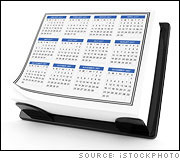- Exception: Century years are NOT leap years UNLESS they can be evenly divided by 400. (For example, 1700, 1800, and 1900 were not leap years, but 1600 and 2000, which are divisible by 400, were.)
Related Links
Leap Year Explained Leap Year Birthdays History of the Calendar History of the Calendar Time & Calendar The Curious History of the Gregorian Calendar How August Became August
Why is a Leap Year Necessary?
Leap years are added to the calendar to keep it working properly. The 365 days of the annual calendar are meant to match up with the solar year. A solar year is the time it takes the Earth to complete its orbit around the Sun — about one year. But the actual time it takes for the Earth to travel around the Sun is in fact a little longer than that—about 365 ¼ days (365 days, 5 hours, 48 minutes, and 46 seconds, to be precise). So the calendar and the solar year don’t completely match—the calendar year is a touch shorter than the solar year. It may not seem like much of a difference, but after a few years those extra quarter days in the solar year begin to add up. After four years, for example, the four extra quarter days would make the calendar fall behind the solar year by about a day. Over the course of a century, the difference between the solar year and the calendar year would become 25 days! Instead of summer beginning in June, for example, it wouldn’t start until nearly a month later, in July. As every kid looking forward to summer vacation knows—calendar or no calendar—that’s way too late! So every four years a leap day is added to the calendar to allow it to catch up to the solar year.
A Quick History Lesson
The Egyptians were the first to come up with the idea of adding a leap day once every four years to keep the calendar in sync with the solar year. Later, the Romans adopted this solution for their calendar, and they became the first to designate February 29 as the leap day.
But Wait! It’s Not Quite that Simple!
The math seems to work out beautifully when you add an extra day to the calendar every four years to compensate for the extra quarter of a day in the solar year. As we said earlier, however, the solar year is just about 365 ¼ days long, but not exactly! The exact length of a solar year is actually 11 minutes and 14 seconds less than 365 ¼ days. That means that even if you add a leap day every four years, the calendar would still overshoot the solar year by a little bit—11 minutes and 14 seconds per year. These minutes and seconds really start to add up: after 128 years, the calendar would gain an entire extra day. So, the leap year rule, “add a leap year every four years” was a good rule, but not good enough!
Calendar Correction, Part II
To rectify the situation, the creators of our calendar (the Gregorian calendar, introduced in 1582) decided to omit leap years three times every four hundred years. This would shorten the calendar every so often and rid it of the annual excess of 11 minutes and 14 seconds. So in addition to the rule that a leap year occurs every four years, a new rule was added: a century year is not a leap year unless it is evenly divisible by 400. This rule manages to eliminate three leap years every few hundred years.
It’s Smooth Sailing for the Next 3,300 Years
This ingenious correction worked beautifully in bringing the calendar and the solar year in harmony, pretty much eliminating those pesky extra 11 minutes and 14 seconds. Now the calendar year and the solar year are just about a half a minute off. At that rate, it takes 3,300 years for the calendar year and solar year to diverge by a day.
